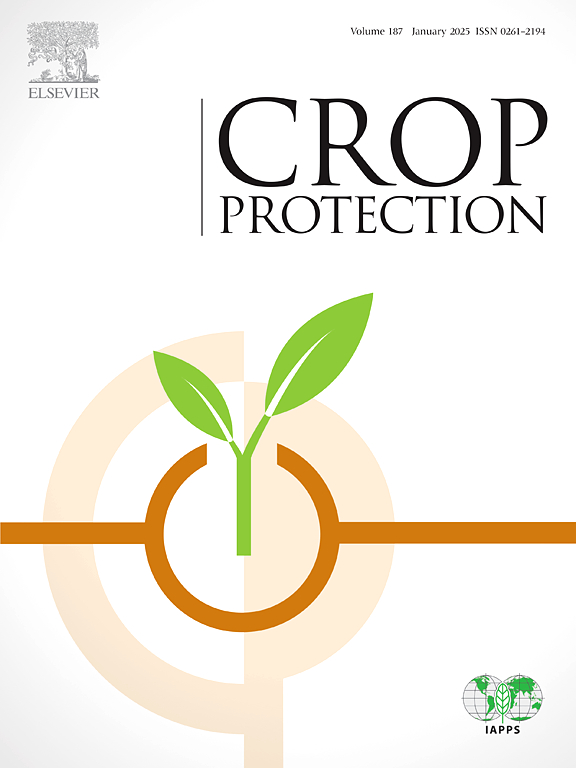Differential parasitism performance and host adaptability of key biocontrol Eretmocerus species against two major whitefly pests
IF 2.5
2区 农林科学
Q1 AGRONOMY
引用次数: 0
Abstract
Whiteflies are major agricultural pests, and their sustainable management depends on effective biological control strategies. This study investigates the preference, the host performance and the host feeding behavior of two key parasitoid species, Eretmocerus corni and Eretmocerus hayati, against Bemisia tabaci and Trialeurodes vaporariorum. To assess host selection, parasitism, host-feeding, emergence rates, developmental times, proportion of female offspring, and total mortality rate across different host species and instars, both no-choice and choice experiments were conducted. Key findings include: (1) E. corni successfully parasitized all instars of both whitefly species, while E. hayati completed its development only in B. tabaci. Both parasitoids achieved the highest parasitism rates and emergence rates on the second and third instars of their respective hosts. (2) E. hayati exhibited superior host-feeding, faster development, and higher total mortality rate compared to E. corni, additionally, both host-feeding rates and developmental time significantly decreased as the host instar increased. (3) Although E. hayati could not complete its development in T. vaporariorum, it caused substantial mortality through aborted parasitism and superior host-feeding. (4) In the choice tests, E. corni showed a significant preference for T. vaporariorum when both whitefly species were at the same instar stage, whereas E. hayati exhibited no notable host preference. (5) Under the mixed-host condition, both E. corni and E. hayati exhibited increased mortality rates against whiteflies at the same instar compared to the single-host condition. These findings offer valuable insights into the host preference, performance of these parasitoids and provide theoretical guidance for optimizing whitefly biological control.

主要生物防治品种白蝇对两种主要粉虱的不同寄生性能及寄主适应性
粉虱是农业主要害虫,其可持续管理依赖于有效的生物防治策略。本研究研究了两种主要寄生蜂——角僵螨和哈氏僵螨对烟粉虱和白粉虱的偏好、寄主性能和寄主摄食行为。为了评估不同寄主种类和不同龄期的寄主选择、寄生、寄主取食、羽化率、发育时间、雌性后代比例和总死亡率,进行了无选择和选择实验。主要发现包括:(1)山角姬蝇成功寄生于两种粉虱的所有幼虫,而哈雅蒂姬蝇仅在烟粉虱中完成发育。两种寄生蜂在各自寄主的2龄和3龄上的寄生率和羽化率最高。(2)与山茱萸相比,叶蛾的取食能力更强,发育速度更快,总死亡率更高,且随着寄主龄期的增加,寄主取食率和发育时间均显著降低。(3) hayati虽然不能完全发育,但由于其寄生失败和优越的寄主取食,造成了大量的死亡。(4)在选择试验中,当两种白蝇处于同一龄期时,玉米螟对白蝇有明显的偏好,而白蝇对不同龄期的寄主没有明显的偏好。(5)在混合寄主条件下,与单寄主条件下相比,玉米螟和叶蛾在同一龄期对白蝇的死亡率均有所提高。这些研究结果为进一步了解粉虱的寄主偏好和寄生性能提供了有价值的见解,并为优化粉虱的生物防治提供了理论指导。
本文章由计算机程序翻译,如有差异,请以英文原文为准。
求助全文
约1分钟内获得全文
求助全文
来源期刊

Crop Protection
农林科学-农艺学
CiteScore
6.10
自引率
3.60%
发文量
200
审稿时长
29 days
期刊介绍:
The Editors of Crop Protection especially welcome papers describing an interdisciplinary approach showing how different control strategies can be integrated into practical pest management programs, covering high and low input agricultural systems worldwide. Crop Protection particularly emphasizes the practical aspects of control in the field and for protected crops, and includes work which may lead in the near future to more effective control. The journal does not duplicate the many existing excellent biological science journals, which deal mainly with the more fundamental aspects of plant pathology, applied zoology and weed science. Crop Protection covers all practical aspects of pest, disease and weed control, including the following topics:
-Abiotic damage-
Agronomic control methods-
Assessment of pest and disease damage-
Molecular methods for the detection and assessment of pests and diseases-
Biological control-
Biorational pesticides-
Control of animal pests of world crops-
Control of diseases of crop plants caused by microorganisms-
Control of weeds and integrated management-
Economic considerations-
Effects of plant growth regulators-
Environmental benefits of reduced pesticide use-
Environmental effects of pesticides-
Epidemiology of pests and diseases in relation to control-
GM Crops, and genetic engineering applications-
Importance and control of postharvest crop losses-
Integrated control-
Interrelationships and compatibility among different control strategies-
Invasive species as they relate to implications for crop protection-
Pesticide application methods-
Pest management-
Phytobiomes for pest and disease control-
Resistance management-
Sampling and monitoring schemes for diseases, nematodes, pests and weeds.
 求助内容:
求助内容: 应助结果提醒方式:
应助结果提醒方式:


